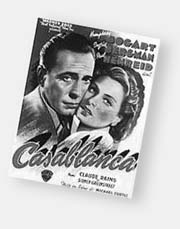|
Film Noir
 UNEXPECTED
NOIR UNEXPECTED
NOIR
Most critics agree that film noir transcends genre
to exist as a body of films characterized by their moody stylistic
approach and an ambivalent undercurrent of cynicism.
During the 1940s, this dark mood and style found its way
into other films that are not usually thought of as classic
film noir, ranging from gangster films, westerns, comedies,
and fantasies, to even films about that prominent symbol of
an ideal America, the small town.
SMALL-TOWN AMERICA1
In discussing the depiction of Small-Town America in Film
during the 1940s, Emanuel Levy remarks that considering the
overpowering national unity and patriotic fervor called for
by the war effort during first half of the decade, "it
is surprising to find a number of small-town films that were
critical of the American Dream and Dominant culture."
In a chapter entitled "The 1940s – Ambivalence
and Cynicism," he writes that some of Hollywood's most
important films about small towns were produced in the 1940s.
He includes in this group: Kings Row, The Magnificent
Ambersons, The Ox-Bow Incident, The Talk of
the Town (all released in 1942), Shadow of a Doubt
(1943), Hail the Conquering Hero and The Miracle
of Morgan's Creek (both in 1944).
Levy concludes that although these films contained varied
themes and styles – and each introduced some innovation
– they all shared one thing in common: a darker, more
cynical vision of small-town America.
IT'S A WONDERFUL LIFE
In 1946, Frank Capra's It's a Wonderful Life was a
leading contender for Best Picture, along with William Wyler's
The Best Years of Our Lives, which ended up the big
winner, sweeping nine Oscars.
In Newsweek's review of a
Wonderful Life, there was an expectation and interpretation
of the film from a populist, idealistic viewpoint. "Like any
number of Capra films that you can name at random –
Mr. Deeds Goes to Town, You Can't Take it With You,
Mr. Smith Goes to Washington – his new film reiterates
his identification with the kindly, possibly oversentimentalized,
"Little" people of these United States."2
Yet James Agee, writing in The Nation,
was more skeptical and saw a moral uncertainty in the film.
"I mistrust even more deeply the assumption, so comfortably
stylish these days, that whether people turn out well or ill
depends overwhelming on outside circumstances and scarcely
if at all on their own moral intelligence and courage. Neither
idea is explicit in this movie, but the whole story depends
on the strong implication and assumption of both."3
Despite
Capra's celebration of an heroic life, the film contains many
cynical elements reflecting wartime and postwar sacrifices.
George's life was never under his own control, and his reluctant
acceptance of domesticity was an interesting change from the
usual portrayal of a woman forced to give up her dreams for
her family. Despite its "happy" ending, Levy writes:
"The train whistle will continue to remind George of
lost opportunities and missed adventurism. In this respect,
Wonderful Life is one of the gloomiest movies ever
made."4
CASABLANCA
Although they argue for the basic optimism
of films in the 1940s, especially during the war years, Leonard
Quart and Albert Auster acknowledge these films often had
"a dark side touched with pessimism and self-doubt"
even as the films basically endorsed and reflected a feeling
of triumph.5
While discussing the overriding purpose of some of these
these patriotic films, they also note that the hero of Casablanca
(1942) lapsed into the cynicism or malaise that occasionally
made its way into wartime movies.
Philip T. Hartung finds a sense
of conflict and uncertainty in the female lead as well, writing
in The Commonweal that, "[Ingrid] Bergman plays this
strange role [the wife of Paul Heinreid, a Czech publisher
who is escaping to America where he will continue his fight
against Nazi Germany] with subtlety and conviction, but the
role itself is not entirely clear because of its continued
vacillation."6
ELEMENTS OF DARKNESS
As Robert Sklar and Jon Tuska, among
others, have noted, dark cynicism and pessimism were not limited
to classic film noirs. Sklar agrees with Levy in citing
Preston Sturges' slapstick satires, The Miracle of Morgan's
Creek and Hail the Conquering Hero (both 1941)
as containing elements of claustrophobia and entrapment. Miracle
dealt with an unwed mother and the 4-F, would-be boyfriend
she tricks into marrying her, while Hail lampooned
America's obsession with war heroes. In each film, a man was
trapped in false situations not of their own making –
a conflicted noir hero played for laughs.7
Other films that are often described as having elements of
noir include the gangster film, White Heat (1949),
the western, Pursued (1947), and the comedy, Unfaithfully
Yours (1948).
The undercurrents of uncertainty and ambivalence that existed
in society could be found in many unexpected places.
Return to Top • Back
to Film Noir
|


